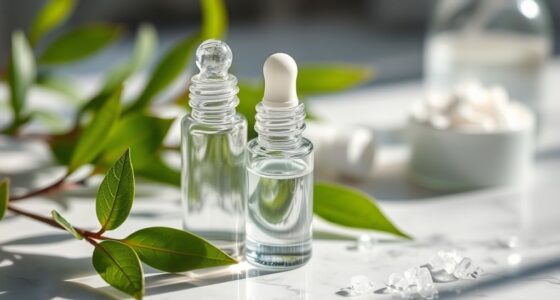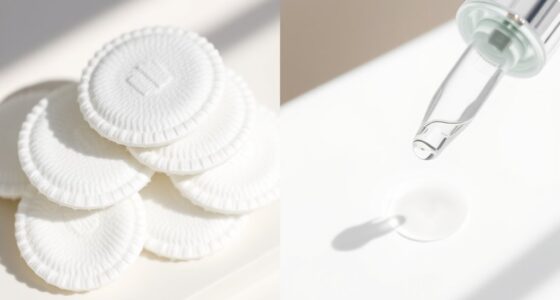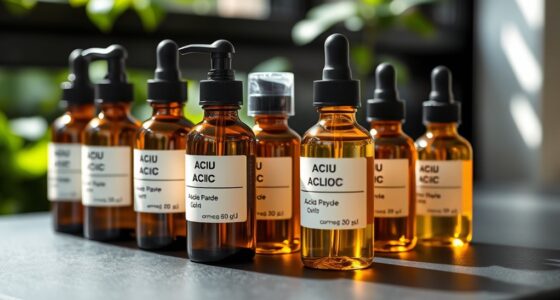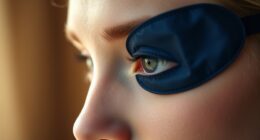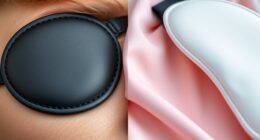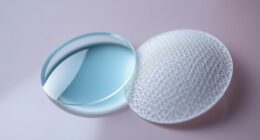When layering toner with retinoids and vitamin C, it’s important to start with a pH-balanced toner to support ingredient stability and skin barrier health. Apply the toner first, then proceed with vitamin C, which performs best at low pH, followed by retinoids once your skin is ready. This sequence helps maximize the benefits while reducing irritation. If you want to discover more tips for effective layering, keep exploring how to optimize your skincare routine.
Key Takeaways
- Apply toner first to restore skin’s natural pH and prepare it for active ingredients.
- Use a pH-balanced, alcohol-free toner to support ingredient stability and skin health.
- Layer vitamin C after toner, as it performs best at low pH, then follow with retinoids to minimize irritation.
- Maintain proper pH balance post-exfoliation and during layering to enhance ingredient absorption and effectiveness.
- Consistently layering in the correct order supports optimal results and preserves the skin’s barrier function.

Layering toner with retinoids and vitamin C can substantially enhance your skincare routine, but it’s important to understand the proper order to maximize benefits and reduce irritation. One key aspect to consider is how these ingredients interact with your skin’s pH balance. Your skin’s natural pH hovers around 4.7, which supports its barrier function and helps prevent bacteria and irritants from penetrating. When you apply products like vitamin C or retinoids, they can temporarily disrupt this balance. Using a toner thoughtfully can help restore or maintain optimal pH, ensuring your skin remains resilient and receptive to active ingredients.
If you’re incorporating chemical exfoliation into your routine, it’s crucial to pay attention to how it influences your skin’s pH. Many chemical exfoliants, like AHAs and BHAs, work best at specific pH levels—usually around 3 to 4—where they can effectively break down dead skin cells. Applying a toner that’s pH-balanced after exfoliation can help restore your skin’s natural acidity, preventing over-exfoliation and irritation. When layering toner, retinoids, and vitamin C, always start with the product that’s most pH-sensitive, typically the toner. This helps set a foundation for the subsequent layers, ensuring each ingredient performs optimally without compromising your skin’s barrier.
Retinoids are powerful but can be irritating if not introduced carefully. Applying them after a pH-balanced toner maximizes their absorption while minimizing irritation. Since retinoids work best when skin is slightly acidic, maintaining that pH environment is essential. Meanwhile, vitamin C, especially in its pure form (ascorbic acid), thrives at a low pH. Applying it on a skin that’s already pH-balanced helps better stability and efficacy. Layering these products correctly—toner first, followed by vitamin C, then retinoids—helps optimize their performance and reduces the risk of irritation caused by pH fluctuations.
Remember that not all toners are created equal. Opt for alcohol-free, pH-balanced toners that complement your skincare ingredients. This approach supports your skin’s natural defenses, enhances ingredient absorption, and minimizes irritation. When you’re deliberate about the order—using toner first to restore pH, then applying vitamin C for antioxidant protection, and finally retinoids for cell turnover—you set a solid foundation for effective, gentle skincare. Proper layering ensures each component works harmoniously, giving you clearer, healthier skin over time.
Additionally, understanding the personal development principles of goal setting and consistency can help you stay committed to your skincare routine, ensuring long-term benefits.
Frequently Asked Questions
Can Layering These Products Cause Skin Irritation?
Yes, layering toner with retinoids and vitamin C can cause skin irritation, especially if your skin sensitivity is high. Product interaction may lead to redness, stinging, or dryness. To minimize irritation, introduce these products gradually, patch test first, and wait a few minutes between applications. Listen to your skin’s signals and adjust your routine accordingly. Using a gentle toner and hydrating products can also help protect your skin.
How Long Should I Wait Between Applying Toner and Retinoids?
Think of it like a dance—timing matters. You should wait about 10-15 minutes between applying toner and retinoids to guarantee proper absorption and minimize irritation. This application timing helps your skin adjust smoothly. Follow the product sequence carefully, starting with toner, waiting, then applying retinoids. Rushing the process might cause irritation, so be patient and give each product time to work effectively.
Is It Necessary to Use Vitamin C in the Morning?
You don’t have to use vitamin C in your morning routine, but it’s beneficial for skin brightness and antioxidant protection. Incorporating vitamin C in the morning helps combat environmental damage and enhances your skin’s glow. If you skip it, focus on other antioxidants or sunscreen. Using vitamin C daily can boost your skin’s energy, but it’s optional based on your skincare goals and routine preferences.
Are There Specific Skin Types That Should Avoid Layering These Products?
Think of your skin as a delicate garden—some plants thrive with extra care, while others need a gentler touch. If you have skin sensitivity or a high allergy risk, layering retinoids and vitamin C might feel like adding too much fertilizer, causing irritation or redness. It’s best to patch test first, and consult a dermatologist. Those with sensitive skin should approach these powerful products cautiously to avoid unnecessary stress.
Can Layering Toner With Retinoids and Vitamin C Improve Skin Texture?
Layering toner with retinoids and vitamin C can improve your skin texture by enhancing absorption and promoting cell turnover. To do this effectively, maintain proper pH balance and guarantee product compatibility, preventing irritation or reduced effectiveness. Use a hydrating toner first, then apply vitamin C for brightening, and finish with retinoids at night. This thoughtful layering can result in smoother, more radiant skin over time.
Conclusion
Layering toner with retinoids and vitamin C can boost your skincare, but don’t assume more is better. Some experts believe combining these active ingredients might cause irritation or reduce their effectiveness. Instead, try using them at different times or on alternate days. Remember, your skin’s response varies, so listen to it. A little patience and careful layering can help you reap the benefits without risking damage—proving that sometimes, less truly is more.


